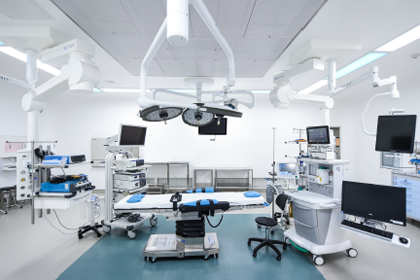Search
Related Articles
What is sciatica?
Sciatica is a condition that causes pain along your sciatic nerve. The sciatic nerve runs from your spine through both sides of your buttocks. It then runs down the back of your thigh, into your lower leg and foot. Any place along your sciatic nerve may be compressed, inflamed, irritated, or stretched and cause symptoms.
What causes sciatica?
Sciatica may be related to certain activities, poor posture, and physical or psychological stress. Any of the following may cause or increase your risk of sciatica:
• Disc problems: A slipped disc (soft cushion in between the bones of the spine) is the most common cause of sciatica. The disc may press on the sciatic nerve. One bone in your spine may slip over another, or you may have narrowing of the spinal column
• Muscle injury: This may happen after you twist or lift a heavy object. Swelling from sprained or irritated muscles in the buttocks, thighs, or legs press on the sciatic nerve
• Obesity or pregnancy: Extra weight increases pressure on your back and legs
• Trauma: Direct blows on the buttocks, thighs, or legs, car accidents, or falls may injure the sciatic nerve
• Diseases of the spine: Arthritis, osteoporosis, cancer, or infection of the spine may also affect the sciatic nerve
What are the signs and symptoms of sciatica?
The symptoms of sciatic may be short-term or long-term:
• Pain that goes from the lower back into your buttocks and down the back of your thigh
• Numbness or tingling in your buttocks and legs
• Muscle weakness, difficulty moving or controlling your leg or foot
• Leg pain that increases with standing, sitting, or squatting
How is sciatica diagnosed?
Your doctor will ask about other health conditions you may have. He may ask you about your job, history of back pain, diseases, or surgeries you have had. He will examine you and move your legs to see what increases pain. You may also need any of the following:
• X-rays: This is a picture of the bones and tissues in your back, hip, thigh, or leg. This test may show other problems, such as fractures (broken bones)
• CT scan: This test is also called a CAT scan. An x-ray machine uses a computer to take pictures of your hips, thighs, and legs. The pictures may show your sciatic nerve, muscles, and blood vessels. You may be given a dye before the pictures are taken to help doctors see the pictures better. Tell the doctor if you have ever had an allergic reaction to contrast dye
• MRI: This scan uses powerful magnets and a computer to take pictures of your hips, thighs, and legs. An MRI may show damaged nerves, muscles, bones, and blood vessels. You may be given dye to help the pictures show up better. Tell the doctor if you have ever had an allergic reaction to contrast dye. Do not enter the MRI room with anything metal. Metal can cause serious injury. Tell the doctor if you have any metal in or on your body
• An electromyography (EMG) test measures the electrical activity of your muscles at rest and with movement
• Nerve conduction tests: These tests check how surface nerves and related muscles respond to stimulation. Electrodes with wires or tiny needles are placed on certain areas, such as the buttocks and legs
How is sciatica treated?
• NSAIDs: These medicines decrease swelling and pain. NSAIDs are available without a doctor's order. Ask your doctor which medicine is right for you. Ask how much to take and when to take it. Take as directed. NSAIDs can cause stomach bleeding or kidney problems if not taken correctly
• Acetaminophen: This medicine decreases pain. Acetaminophen is available without a doctor's order. Ask how much to take and how often to take it. Follow directions. Acetaminophen can cause liver damage if not taken correctly
• Muscle relaxers help decrease pain and muscle spasms
• Epidural steroid medicine: This may include both an anesthetic (numbing medicine) and a steroid, which may decrease swelling and relieve pain. It is given as a shot close to the spine in the area where you have pain
• Chemonucleolysis: This is an injection given into the damaged disc to soften or shrink the disc
• Surgery: This may be done to correct problems such as a damaged disc, or a tumor in your spine. It may be done to decrease the pressure on the sciatic nerve. Doctors may also release the muscle that may be pressing into your sciatic nerve
How can I help manage sciatica?
• Ultrasound therapy: This is a machine that uses sound waves to decrease pain. Topical medicines may be added to help decrease pain and inflammation
• Physical therapy: A physical therapist teaches you exercises to help improve movement and strength, and to decrease pain. An occupational therapist teaches you skills to help with your daily activities
• Assistive devices: You may need to wear back support, such as a back brace. You may need crutches, a cane, or a walker to decrease stress on your lower back and leg muscles. Ask your doctor for more information about assistive devices and how to use them correctly
How can sciatica be prevented?
• Avoid pressure on your back and legs: Do not lift heavy objects, or stand or sit for long periods of time
• Lift objects safely: Keep your back straight and bend your knees when you pick up an object. Do notbend or twist your back when you lift
• Maintain a healthy weight: Ask your doctor how much you should weigh. Ask him to help you create a weight loss plan if you are overweight
• Exercise: Ask your doctor about the best stretching, warm up, and exercise plan for you
What are the risks of sciatica?
An epidural steroid injection can lead to pain disorders or paralysis if it is placed incorrectly. It may also cause headaches, leg pain, and blockage of blood flow to the spinal cord. Surgery may cause you to bleed or get an infection. If not treated, your muscles and nerves may become damaged permanently. You may have decreased strength. You may not be able to move your leg or control when you urinate or have bowel movements.
When should I contact my doctor?
• You have pain in your lower back at night or when resting
• You have pain in your lower back with numbness below the knee
• You have weakness in one leg only
• You have questions or concerns about your condition or care
When should I seek immediate care or call 120?
• You have trouble holding back your urine or bowel movements
• You have weakness in both legs
• You have numbness in your groin or buttocks
CARE AGREEMENT:
You have the right to help plan your care. Learn about your health condition and how it may be treated. Discuss treatment options with your caregivers to decide what care you want to receive. You always have the right to refuse treatment.
© 2017 Truven Health Analytics LLC All illustrations and images included in CareNotes® are the copyrighted property of A.D.A.M., Inc. or Truven Health Analytics.
Click the link for more information on Orthopaedics and Sports Medicine Clinical Service
Click the link for more information on Neurology Clinical Service











